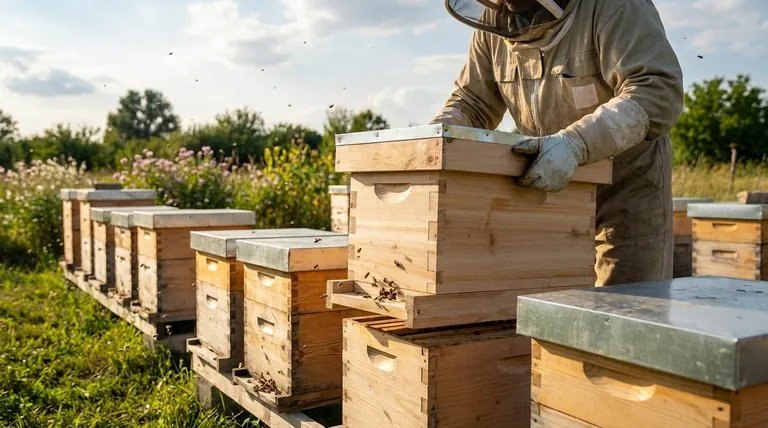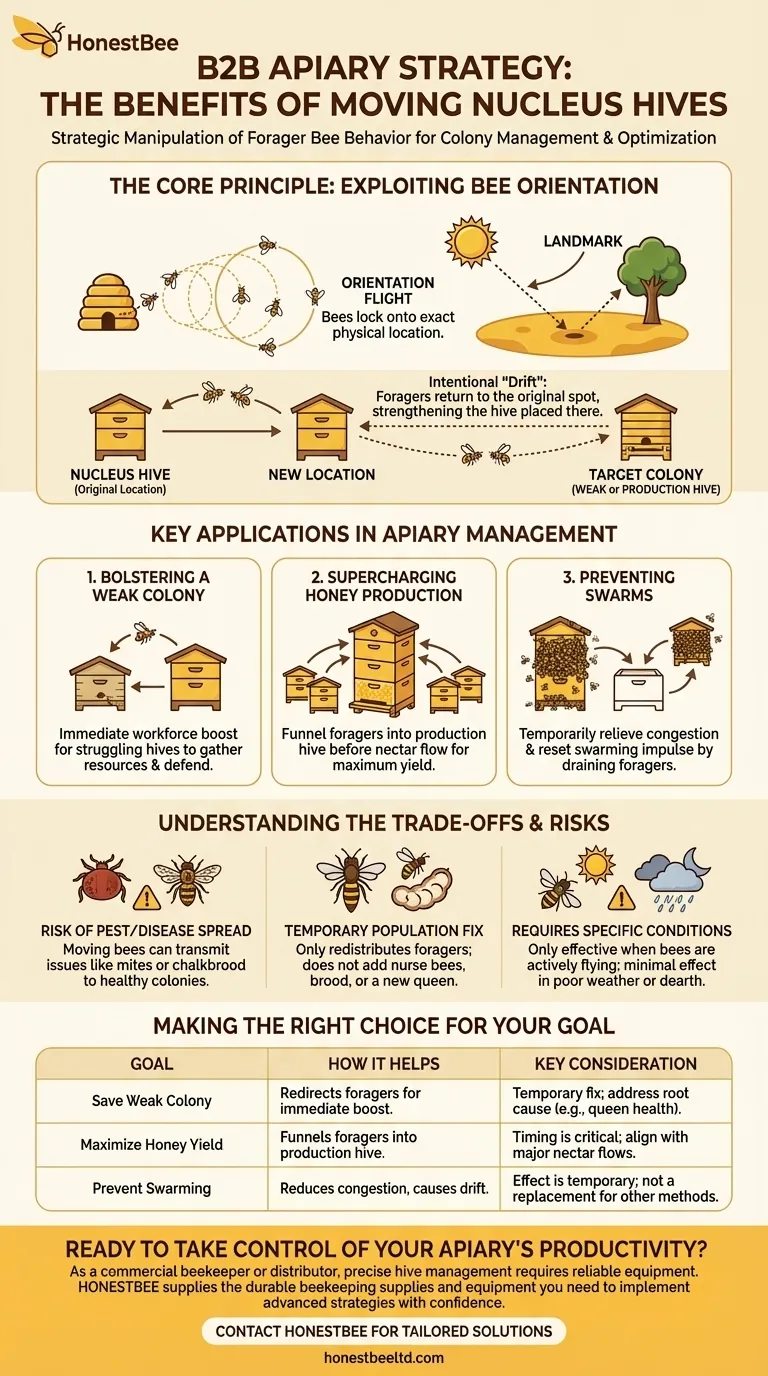At its core, moving nucleus hives around an apiary is a strategic manipulation of bee behavior. It is a technique used to deliberately redistribute the forager bee population between colonies. This allows a beekeeper to either strengthen a target colony by giving it more foragers or weaken a colony by taking its foragers away.
The primary benefit is gaining precise control over colony strength. By relocating a nucleus hive, you leverage the natural homing instinct of forager bees to intentionally redirect them into a different hive, achieving specific management goals like swarm prevention or boosting a weaker colony.

The Core Principle: Exploiting Bee Orientation
To understand this technique, you must first understand how forager bees navigate. They don't just recognize their hive; they lock onto its exact physical location.
How Forager Bees Orient
When bees first emerge and begin flying, they perform orientation flights. They exit the hive, turn to face it, and fly in expanding circles, memorizing the hive's position relative to landmarks like trees, fences, and the sun.
Once this location is set, foragers will return to that precise spot with remarkable accuracy after every trip.
Creating Intentional "Drift"
Moving a nucleus hive exploits this behavior. If you move a nuc to a new location within the apiary, its foragers will still return to the original spot.
If another hive now occupies that spot, those returning foragers will join it. This intentional redirection of the workforce is the foundation of the technique.
Key Applications in Apiary Management
This is not a random shuffling of boxes. It's a calculated move to solve specific problems or optimize your apiary's performance.
Bolstering a Weak Colony
A common application is to save a weak or struggling hive. By placing a strong nucleus hive next to the weak one and later moving it, the returning foragers from the nuc will enter and strengthen the weak colony.
This provides an immediate boost to the weak hive's foraging capacity, helping it bring in resources and defend itself while you address the root cause of its weakness (e.g., replacing a poor queen).
Supercharging Honey Production
The same principle can be used to maximize the output of a strong, productive colony just before or during a major nectar flow.
By moving one or more nucleus hives, you can funnel their foraging workforce into your designated "production" hive. This massive, temporary influx of foragers can significantly increase the amount of nectar that colony can collect.
Preventing Swarms
Congestion is a primary trigger for swarming. If a powerful colony is running out of space and its population is booming, you can use this technique to temporarily weaken it.
By moving the strong colony and putting a smaller nuc or an empty box in its place, you drain away its foraging force. This reduces internal congestion and can reset the swarming impulse without having to split the colony.
Understanding the Trade-offs and Risks
While powerful, this technique is not without its downsides. It must be used with a clear understanding of the potential consequences.
Risk of Spreading Pests and Disease
Moving bees between colonies is a highly effective way to spread problems. If the nucleus hive has a high Varroa mite load or a disease like chalkbrood, its drifting foragers will carry those issues directly into the healthy target colony.
It's a Temporary Population Fix
This method only redistributes forager bees. It does not add nurse bees, brood, or a new queen to the receiving colony.
If a colony is weak because of a failing queen or disease, adding foragers is only a short-term patch. You must still solve the underlying problem for the colony to recover long-term.
Requires Specific Conditions
The technique is only effective when bees are actively flying. Attempting it during poor weather, a nectar dearth, or late in the evening will have a minimal effect because the forager population is inside the hive, not out working.
Making the Right Choice for Your Goal
Apply this technique with a clear, specific objective in mind. It is a precise tool for managing hive dynamics, not a general solution.
- If your primary focus is saving a weak colony: Use foragers from a strong, healthy nuc to provide a temporary workforce boost while you fix the core issue.
- If your primary focus is maximizing honey yield: Redirect foragers from several support colonies into your strongest production hive right before a major nectar flow.
- If your primary focus is swarm prevention: Temporarily depopulate an overly crowded hive by moving it, allowing its foragers to disperse and relieve congestion.
Ultimately, mastering this method transforms you from a reactive to a proactive beekeeper, giving you direct control over the balance and productivity of your apiary.
Summary Table:
| Goal | How Moving a Nuc Helps | Key Consideration |
|---|---|---|
| Strengthen a Weak Colony | Redirects foragers from a strong nuc to provide an immediate workforce boost. | Only a temporary fix; must address the root cause of weakness (e.g., queen health). |
| Maximize Honey Production | Funnels foragers from multiple nucs into a single production hive before a nectar flow. | Timing is critical; must align with major nectar flows for maximum effect. |
| Prevent Swarming | Temporarily reduces congestion in a strong hive by moving it, causing foragers to drift away. | Effect is temporary; does not replace other swarm control methods like adding space. |
| General Apiary Balance | Provides proactive control over colony population and resource distribution. | Risk of spreading pests/disease; only use with healthy colonies. |
Ready to take control of your apiary's productivity?
As a commercial beekeeper or distributor, precise hive management is key to your success. The strategic movement of nucleus colonies is a powerful technique, but it requires reliable, high-quality equipment to execute effectively.
HONESTBEE supplies the durable beekeeping supplies and equipment you need—from nucleus boxes to full hive setups—to implement these advanced strategies with confidence. Our wholesale-focused operations are designed to meet the demands of commercial apiaries and equipment distributors.
Let's discuss how our products can support your specific management goals. Contact our team today to get tailored solutions for a more productive and profitable operation.
Visual Guide

Related Products
- 5 Frame Wooden Nuc Box for Beekeeping
- Twin Queen Styrofoam Honey Bee Nucs Mating and Breeding Box
- Automatic Heat Preservation 6 Frame Pro Nuc Box for Honey Bee Queen Mating
- Plastic Transporting Bee Packages and Nuc Boxes for Beekeeping
- Portable Bee Mating Hive Boxes Mini Mating Nucs 8 Frames for Queen Rearing
People Also Ask
- How many frames does a typical wooden nuc box hold? A Guide to Choosing the Right Size
- How should the nuc be installed in the apiary? Ensure Colony Success from Day One
- What is a common feature of many 5-frame nuc boxes? The Integrated Feeder for Efficient Colony Growth
- What are the benefits of using nucs for beginning beekeepers? Ensure a Successful First Hive with a Head Start
- What frames should be moved into the queenless hive when requeening with a nuc? Ensure a Successful Queen Introduction



















